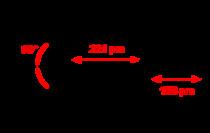Appearance colorless liquid Boiling point 30.1 °C | Formula S2F10 Melting point -53 °C | |
 | ||
Disulfur decafluoride (S2F10) is a gas discovered in 1934 by Denbigh and Whytlaw-Gray. Each S of the S2F10 molecule is octahedral, and surrounded by 5 fluorines. S2F10 is highly toxic, with toxicity 4 times that of phosgene. It was considered a potential chemical warfare pulmonary agent in World War II because it does not produce lacrimation or skin irritation, thus providing little warning of exposure. It is produced by the electrical decomposition of sulfur hexafluoride (SF6)—an essentially inert insulator used in high voltage systems such as transmission lines, substations and switchgear. S2F10 is also made during the production of SF6, but is distilled out.
Contents
Production
Disulfur decafluoride is produced primarily by the decomposition of sulfur hexafluoride:
2 SF6 → S2F10 + F2
Properties
This compound contains sulfur in the sp3d2 hybridization where 2 sulfur atoms have zero polarization between them and 5 polarized connections with fluorine atoms.
At temperatures above 150 °C, S
2F
10 decomposes slowly to SF
6 and SF
4:
S2F10 → SF6 + SF4
S
2F
10 reacts with N
2F
4 to give SF
5NF
2. It reacts with SO
2 to form SF
5OSO
2F in the presence of ultraviolet radiation.
In the presence of excess chlorine gas, S
2F
10 reacts to form sulfur chloride pentafluoride (SF
5Cl):
2F
10 + Cl
2 → 2 SF
5Cl
The analogous reaction with bromine is reversible and yields SF
5Br. The reversibility of this reaction can be used to synthesize S
2F
10 from SF
5Br.
Ammonia is oxidised by S
2F
10 into NSF
3.
Toxicity
Disulfur decafluoride is a colorless gas or liquid with a sulfur-dioxide-like odor. It is about 4 times as poisonous as phosgene. Its toxicity is thought to be caused by its disproportionation in the lungs into SF
6, which is inert, and SF
4, which reacts with moisture to form sulfurous acid and hydrofluoric acid. Disulfur decafluoride itself is not toxic due to hydrolysis products, since it is hardly hydrolysed by water and most aqueous solutions.
